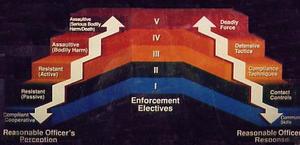Border securityDHS revises rules for use of deadly force on border
On 30 May DHS released new guidelines detailing when the use of force by Border Patrol officials is authorized. The lack of explicit scenarios within the rules, however, has led to questions of when such acts are truly warranted.

Perception and appropriate response guide for Border Patrol agents // Source: www.nij.gov
On 30 May DHS released new guidelines detailing when the use of force by Border Patrol officials is authorized. The lack of explicit scenarios within the rules, however, has led to questions of when such acts are truly warranted.
As the Los Angeles Times reports, these new revisions arrive amidst increasing criticism of unreasonable use of force and a much publicized, leaked damning internal report — both within the past six months. This documentation reveals some glaring abuses, including the fact “that some border agents stood in front of moving vehicles as a pretext to open fire and that agents could have moved away from rock throwers instead of shooting at them.”
Additionally, Mexican officials have complained for years that U.S. border agents who kill Mexicans are rarely disciplined, with little light is shed on the reports of such incidents until years later. Christopher Wilson, an expert on U.S.-Mexico relations at the Woodrow Wilson Center, told the Times, “There needs to be a level of accountability if you want to change the culture and the pattern. People are being killed that don’t need to be killed.” It is estimated that at least twenty people have been killed in Border Patrol confrontations since 2010.
Following this, the new instructions, based on recommendations by Washington, D.C.-based think tank Police Executive Research Forum, “expressly prohibit agents from shooting at the operator of a moving vehicle unless the driver poses a deadly threat to an officer or another person.”
There is no substantial change, however, to the policies regarding attacks with stones. Shawn Moran, the vice president of the Border Patrol agents union, said, “U.S. Customs and Border Protection (CBP) realized the unique environment we are in and kept in place the ability to defend ourselves against vehicular assaults and stone attacks.”
Gil Kerlikowske, the head of CBP, promised to be more transparent going forward, but refused to comment on how many agents had been disciplined for their forceful abuses since 2010.
The new policy will also require mandatory drug testing of any agent that has been involved in a use-of-force exchange and expect agents to have “less lethal” weapons on their person, such as pepper spray, rubber bullets and Tasers.
